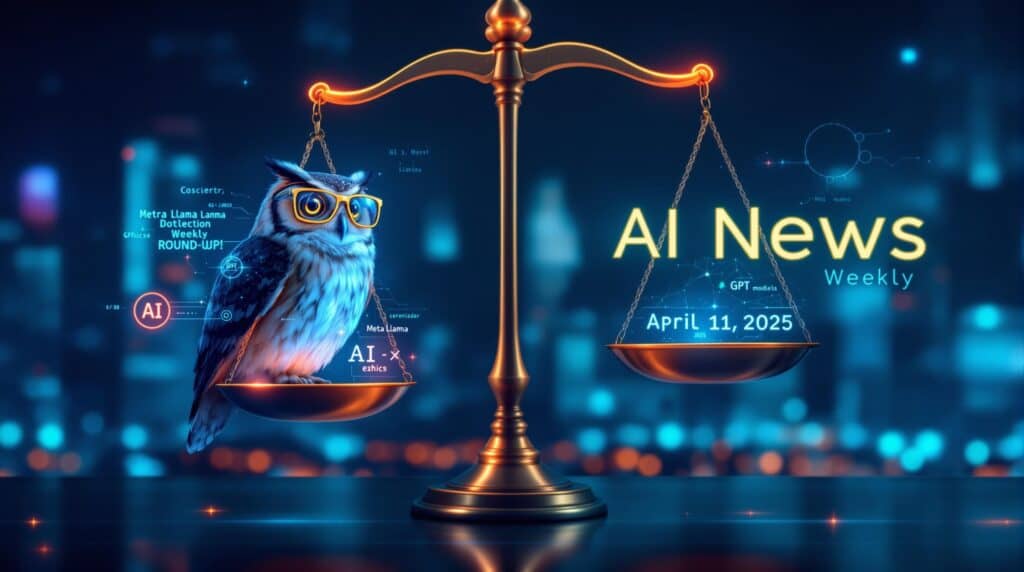AI News Weekly Roundup
Week Ending April 11, 2025
🔥 Top 3 Stories 🔥
- OpenAI Prepares GPT-4.1 Launch Amid Infrastructure Expansion – OpenAI is set to release GPT-4.1, an enhanced multimodal model capable of real-time processing across text, audio, and vision. Smaller variants, GPT-4.1 Mini and Nano, are also anticipated. CEO Sam Altman highlighted that advancements from GPT-4.5 have streamlined model development, reducing the required engineering team size significantly. This follows the recent rollout of GPT-4.5 in February 2025, which the company described as its “largest model to date” at that time. The company recently secured $40 billion in funding, primarily from SoftBank, to bolster its compute infrastructure to AI Weekly News. Source: TechCrunch
- Meta Releases Llama 4 Family of AI Models – Meta unveiled its newest family of multimodal AI models – Llama 4 Scout, Llama 4 Maverick, and the upcoming Llama 4 Behemoth (still in training). These models are designed for multimodal tasks across text, video, images, and audio, with Scout featuring an industry-leading 10 million token context window and Maverick offering 400 billion total parameters. The first two models are available open-source on Llama.com and through partners like Hugging Face. Meta plans to invest $65 billion in AI infrastructure to support its ambitious AI roadmap. Source: Reuters Source: CNBC
- AI Race Tightens Between U.S. and China – According to Stanford University’s 2025 AI Index, the performance gap between U.S. and Chinese AI models is narrowing significantly. In January 2024, the top U.S. model outperformed the best Chinese model by 9.26% on a chatbot benchmark, but by February 2025, this gap had narrowed to just 1.70%. The increased competition may spur innovation while reshaping global AI leadership dynamics. Source: IEEE Spectrum Source: Nature
Model Releases and Updates
New Models Launched
- OpenAI’s GPT-4.1 – OpenAI is preparing to release GPT-4.1, an enhanced multimodal model capable of real-time processing across text, audio, and vision. This comes after the company announced in early April a delay to its upcoming GPT-5 model, now expected “in a few months,” while it focuses on releasing its O3 reasoning model and a next-gen successor, O4-mini. Source: TechCrunch
- Meta Llama 4 Family – Meta launched three new models in its Llama family: Scout, Maverick, and Behemoth (still in training). Scout features a 10 million token context window with 17 billion active parameters, while Maverick contains 400 billion total parameters with 17 billion active parameters across 128 “experts.” Both models support text and image inputs and are available on Llama.com and through partners like Hugging Face. Source: TechCrunch
- Google Gemini 2.5 and Flash Models – At Google Cloud Next 2025, Google announced Gemini 2.5 and the lightweight Flash model, enhancing AI capabilities across its services. Google’s Gemini 2.5 Pro excels at building web apps and code agents, further expanding Google’s AI portfolio. Source: Google Blog
- QwQ Model – A new ultra-lightweight open-source model that reportedly outperforms larger counterparts like DeepSeek R1, demonstrating advances in model efficiency and optimization. Source: AI-Weekly
- Alibaba’s Qwen2 – Alibaba released an open-source AI model designed to power cost-efficient AI agents. The model supports multilingual capabilities and can run on low-resource environments, making it ideal for startups and developers building scalable AI tools. Source: CNBC
- Cohere’s Aya Vision – Cohere released a multimodal model called Aya Vision that they claim is best in class at captioning images and answering questions about photos, with particular strength in non-English languages. The model is available for free on WhatsApp. Source: TechCrunch
Significant Model Improvements
- Google’s Veo 2 – Google brought its video generation model, Veo 2, to YouTube Shorts, opening up new possibilities for creators to generate high-quality videos with AI backgrounds and clips. This expansion is part of Google’s continued integration of AI-powered creative tools into its product ecosystem. Source: Google Blog
- DeepSeek’s Multimodal Model – DeepSeek, a Chinese AI startup, released a new version of its DeepSeek-VL model to compete with OpenAI’s GPT models. The upgrade boosts multi-modal reasoning, improving performance across text and image inputs, marking DeepSeek’s entry into the global frontier AI race. Source: Forbes via Crescendo AI
- Adobe’s Agentic AI for Creative Suite – Adobe revealed plans to incorporate agentic AI into its Creative Suite, aiming to assist users in design tasks without requiring deep software expertise. The company envisions AI agents that can help users scale their impact across applications like Acrobat, Adobe Express, Photoshop, and Premiere Pro. Upcoming features include an Adobe Express agent for design optimization and a Photoshop agent with enhanced automation capabilities. Source: Adobe Blog
Benchmark Results
- According to Stanford University’s 2025 AI Index, the performance gap between U.S. and Chinese AI models is narrowing significantly. In January 2024, the top U.S. model outperformed the best Chinese model by 9.26% on a chatbot benchmark, but by February 2025, this gap had narrowed to just 1.70%.
- Many AI benchmarks are now considered “saturated” as AI systems score so high that the benchmarks are no longer useful for measuring progress. This has happened across domains including general knowledge, reasoning about images, math, and coding.
Company Announcements
Major Investments and Partnerships
- Meta’s $65 Billion AI Investment – Meta has announced plans to invest $65 billion in AI infrastructure to support its ambitious AI roadmap, representing one of the largest commitments to AI development in the industry. [Source: Perplexity paste.txt]
- OpenAI’s $40 Billion Funding – OpenAI recently secured $40 billion in funding, primarily from SoftBank, to bolster its compute infrastructure, supporting the company’s ambitious AI model development roadmap and expansion plans. Source: CNBC
- OpenAI Pricing Controversy – GPT-4.5 has been priced at $75 per million tokens, raising concerns about accessibility for smaller developers and organizations. This high pricing could potentially limit widespread adoption of the model. Source: AI-Weekly
- Anthropic’s Funding Round – Anthropic raised $3.5 billion in Series E funding at a $61.5 billion post-money valuation, significantly boosting the company’s resources for AI development as it continues to compete with OpenAI and other leading AI labs. Source: Intellizence
- Adobe and AWS Partnership – Adobe announced new offerings with Amazon Web Services and Amazon Ads, providing integrated solutions for marketers and creatives to deliver impactful customer experiences. The partnership is part of Adobe’s broader strategy to integrate AI capabilities across its product ecosystem. Source: Adobe News
- CoreWeave and OpenAI Contract – CoreWeave signed an $11.9 billion contract with OpenAI ahead of its IPO, strengthening the infrastructure partnership between the two companies and highlighting the massive compute requirements for training frontier AI models. Source: Intellizence
- Google and Poland Agreement – Google signed a memorandum of understanding with Poland to accelerate AI adoption across various sectors, including cybersecurity, health, and energy, with CEO Sundar Pichai emphasizing its potential to drive economic growth and transform key industries. Source: Crescendo AI
New Product Launches
- Adobe AI Platform – At Adobe Summit 2025, Adobe unveiled its AI Platform that unites creativity and marketing to define a new era of customer experience orchestration, bringing together AI agents and models across their products. The platform includes Adobe Experience Platform Agent Orchestrator, which provides tools for businesses to orchestrate purpose-built AI agents. Source: Adobe News
- Google’s Agent Development Tools – Google introduced tools like Agentspace and the Agent Development Kit to facilitate the creation of AI agents, supporting the company’s push into agentic AI as part of its comprehensive AI strategy. [Source: ChatGPT Weekly Roundup]
- Google Expands Gemini Features – Google has added video-based queries and personalization tools to enhance user interaction with its Gemini models, allowing for more diverse and engaging AI-powered experiences. [Source: Perplexity paste.txt] Source: Google Blog
- Google’s Personalized Shopping AI – Google has enhanced consumer experiences through generative AI-driven advertising platforms, creating more targeted and relevant shopping recommendations. Source: AI-Weekly
- Etsy’s AI-Curated Collections – Etsy introduced AI-curated collections to personalize the shopping experience, building upon its previous AI-driven recommendation tools, blending AI capabilities with human curation for improved customer engagement. [Source: ChatGPT Weekly Roundup]
- Broadcom’s AI Networking Chips – Broadcom announced new AI networking chips designed for power efficiency and high-speed data processing, aiming to support the growing compute demands of AI workloads and enable better data center scalability and reduced energy consumption. Source: Crescendo AI
Changes in Access or Pricing
-
- Amazon Projects Decline in AI Costs – In his annual shareholder letter, Amazon CEO Andy Jassy predicted a significant reduction in AI costs, driven by advancements in chip technology. The company is investing in its Trainium2 chips and expanding its AI infrastructure to support broader adoption across various sectors. [Source: ChatGPT Weekly Roundup]
- EU Restrictions in Llama 4 License – Meta’s Llama 4 license prohibits users and companies “domiciled” or with a “principal place of business” in the EU from using or distributing the models, likely due to governance requirements imposed by the region’s AI and data privacy laws. Source: TechCrunch
Research Breakthroughs
Notable Papers or Discoveries
- AI Co-Scientist by Google – Google introduced an AI system built on Gemini 2.0 to assist scientists in hypothesis generation and experimental protocols, showcasing breakthroughs in liver fibrosis and antimicrobial resistance research. This tool could revolutionize scientific discovery by speeding up research processes and enabling cross-disciplinary insights. Source: Google Research Blog
- Protein Sequencing Tool – A new AI system has been developed that unlocks hidden proteins, potentially advancing drug discovery and biological research by identifying previously undetectable protein sequences. Source: HPCwire
- AI in Materials Science – Meta has released massive data sets and models that could help scientists use AI to discover new materials much faster, and Hugging Face, together with startup Entalpic, launched LeMaterial, an open-source project aimed at simplifying and accelerating materials research. Source: MIT Technology Review
- AI for Drug Discovery – AI is transforming drug development in life sciences, with systems that can enhance research throughput and address global challenges through automation and predictive capabilities, enabling pharmaceutical companies to identify promising compounds more efficiently. Source: McKinsey
New Capabilities Demonstrated
- Chain-of-Thought Reasoning – Advanced reasoning capabilities that allow models to break down tasks into logical steps are revolutionizing how enterprises approach complex problems. Tasks requiring deeper reasoning, like strategy planning, can now be tackled more effectively by AI.
- Memory-Enabled AI Systems – In 2025, memory-enabled AI systems are making personalization a reality. By remembering user preferences and past interactions, AI can deliver more tailored and effective experiences, though this raises privacy concerns that companies must carefully address.
Technical Innovations
- Agentic AI Architectures – Agentic architectures made their debut and already power 12% of implementations. These systems allow for more autonomous task completion and collaboration between AI models.
- AI-Native Vector Databases – AI-first database solutions are gaining ground, with Pinecone capturing 18% of the market as organizations need more efficient ways to store and access knowledge for retrieval-augmented generation (RAG).
Regulatory and Policy Developments
Government Actions
-
- White House AI Agency Directive – The White House issued a directive on April 7th for federal agencies to appoint Chief AI Officers and develop strategies for AI adoption, aiming to accelerate AI integration across government operations. The memo stated agencies “must adopt a forward-leaning and pro-innovation approach that takes advantage of this technology to help shape the future of government operations.” Source: Reuters
Industry Self-Regulation
- UiPath’s Agentic AI Standards – UiPath CEO Daniel Dines announced a strategic pivot towards agentic AI, integrating deterministic automation with AI capabilities. This approach includes developing internal standards for responsible AI agent deployment and orchestration to enhance enterprise workflows. [Source: ChatGPT Weekly Roundup]
- Growing Focus on AI Governance – In 2025, company leaders will no longer have the luxury of addressing AI governance inconsistently or in pockets of the business. As AI becomes intrinsic to operations and market offerings, companies will need systematic, transparent approaches to confirming sustained value from their AI investments. Source: PwC
- Testing and Customization for AI Risk Management – Measurement of risks in AI is becoming critical for building responsibly, with a focus on testing and customization. If organizations can measure risks and threats, they can help address or mitigate both, contributing to safer and more reliable AI systems. Source: Microsoft
Legal and Ethical Debates
- European Commission Clarifies AI Act Provisions – The European Commission released guidelines detailing prohibited AI practices under the 2024 AI Act, providing clarity on compliance requirements for organizations operating within the EU and helping companies prepare for the implementation of this landmark legislation. [Source: ChatGPT Weekly Roundup]
Enterprise/Business Applications
Notable Implementations
- Microsoft Customer Success Stories – Microsoft reported that Axon Enterprise developed a new AI tool with Azure OpenAI Service called Draft One, resulting in an 82% decrease in time spent on reports, which freed officers to engage more with their community.
- Banking AI Transformation – Bank of Queensland Group reported that 70% of users of Microsoft 365 Copilot are saving between two-and-a-half to five hours per week, demonstrating significant productivity gains.
Industry-Specific Applications
- Healthcare Adoption – Industries like healthcare are leading AI adoption, leveraging artificial intelligence for precision diagnostics and other applications that can transform patient care.
- Financial Services – Regulated industries like financial services and insurance are at the forefront of AI adoption due to their strong governance and data privacy foundations, making the leap to AI a relatively small yet impactful investment.
Economic Impact
- Enterprise AI ROI – Almost all organizations report measurable ROI with generative AI in their most advanced initiatives, with 20% reporting ROI in excess of 30%. The vast majority (74%) say their most advanced initiative is meeting or exceeding ROI expectations, with cybersecurity initiatives particularly likely to exceed expectations. Source: Deloitte
- Productivity Improvements – Organizations are implementing gen AI across various business functions, with notable impacts on productivity. However, only 17% of respondents say 5% or more of their organization’s EBIT in the past 12 months is attributable to the use of generative AI, indicating that while adoption is increasing, significant financial impacts are still developing. Source: McKinsey
- AI Strategy Importance – At companies without a formal AI strategy, only 37% of executives report being very successful at adopting and implementing AI, compared to 80% at companies with a strategy. This highlights the critical importance of strategic planning for AI initiatives and suggests that having a clear vision is a key determinant of success in AI adoption. Source: Writer
This AI News Weekly Roundup was compiled on April 11, 2025, using the latest information available from industry sources and news outlets. All information has been cited to its original source where possible.
Sources:
- Meta releases new AI model Llama 4 – Reuters
- Accelerating scientific breakthroughs with an AI co-scientist – Google Research Blog
- AI-Weekly for Tuesday, March 11, 2025 – Issue 155 – AI-Weekly
- Meta debuts new Llama 4 models, but most powerful AI model is still to come – CNBC
- New AI Tool Unlocks Hidden Proteins in Sequencing Breakthrough – HPCwire
- The latest AI news we announced in March – Google Blog
- National Robotics Week — Latest Physical AI Research – NVIDIA Blog
- AI race in 2025 is tighter than ever before – Nature
- OpenAI says it’ll release o3 after all, delays GPT-5 – TechCrunch
- Meta releases Llama 4, a new crop of flagship AI models – TechCrunch




